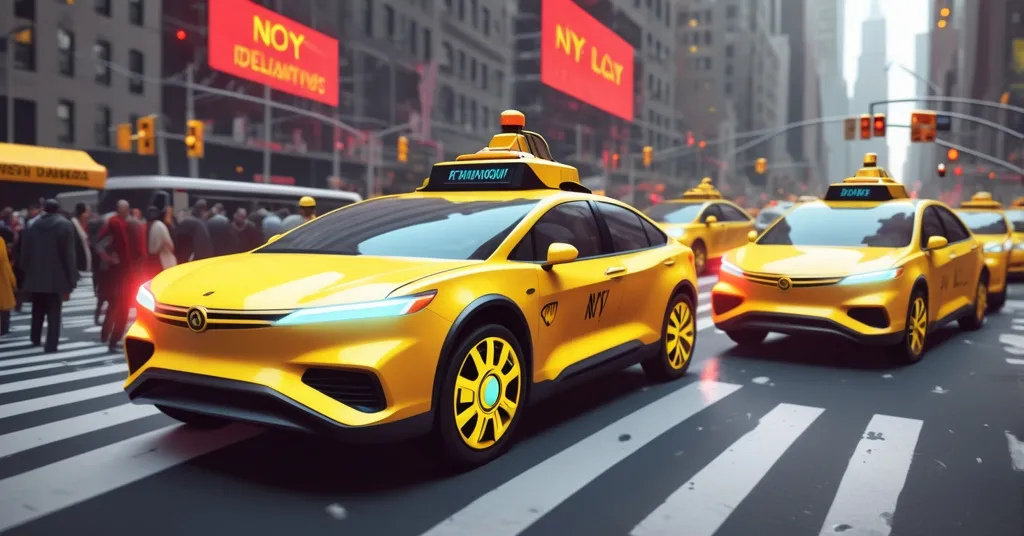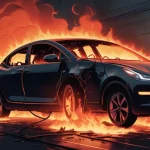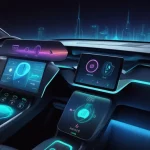Tesla’s Unpermitted Autonomous Testing in NYC Ignites Safety and Regulatory Fury

Tesla’s Rogue Push: Testing Autonomous Vehicles in NYC Without Permits Sparks Outrage
Tesla is stirring up a storm in New York City by hiring drivers to test its self-driving technology on public streets without obtaining the required permits. This audacious move, part of a broader nationwide sprint to advance its Full Self-Driving (FSD) system, pits Elon Musk’s relentless drive for innovation against critical safety and regulatory barriers. As champions of disruption and decentralization, we admire the ambition to redefine transportation, but this gamble in one of the world’s most chaotic urban centers raises serious red flags about responsibility and public trust.
- Tesla recruits drivers in Queens for data collection, bypassing NYC permit rules.
- NYC DOT confirms no permit application; safety drivers are mandatory for AV testing.
- Safety risks, legal battles, and tech gaps haunt Tesla’s robotaxi dreams amid EV sales slump.
Unpermitted Testing: A Reckless Gamble on NYC Streets
Tesla’s latest stunt involves job postings in Queens, seeking drivers to operate vehicles decked out with automated driving systems. Their task is straightforward—collect audio and video data to train the company’s Full Self-Driving technology, a system marketed as a stepping stone to full autonomy but still heavily reliant on human oversight. The catch? The New York City Department of Transportation (DOT) has publicly stated that Tesla hasn’t even bothered to apply for the permits needed to legally test autonomous vehicles (AVs) in the city. NYC rules are crystal clear: any company dabbling in AV testing must have a trained safety driver behind the wheel at all times, ready to intervene if the tech falters. Ignoring this isn’t just a slap in the face to regulators—it’s a dangerous roll of the dice in a city where pedestrians dart across streets like they’re playing Frogger and cabbies drive like they’re auditioning for a Fast & Furious sequel.
Picture this: a Tesla test car cruising through Times Square, weaving between oblivious tourists and double-parked delivery trucks, with no guarantee of a safety driver poised to hit the brakes. That’s the nightmare scenario NYC faces with Tesla’s unpermitted testing operation. The Big Apple isn’t a sandbox for beta testing tech that’s nowhere near foolproof. A single glitch—a missed stoplight, a misread crosswalk—could turn into a headline disaster, not just for Tesla but for the entire AV industry, which already battles public skepticism after high-profile crashes.
Regulatory Defiance: Tesla’s Rule-Breaking Spans the U.S.
Tesla’s NYC escapade is just one piece of a larger, aggressive push to scale testing across the country. Job listings have surfaced in cities like Dallas, Houston, Tampa, Orlando, Miami, and Palo Alto, California, showing Musk’s intent to flood the map with data-collecting Teslas. In Texas, the company recently bagged a permit to run robotaxi services without a human driver, and since June, a small, invite-only fleet has been active in Austin, with Musk teasing a public rollout soon. A similar limited autonomous ride-hailing setup operates in San Francisco, though California regulators have clipped Tesla’s wings, banning terms like “taxi” or “cab” and prohibiting fully driverless operation for now.
“Working as quickly as possible to get 100+ Teslas operating for autonomous ride-hailing (can’t use the word ‘taxi’ or ‘cab’ in California) in the Bay Area and allow anyone to request a ride.” — Elon Musk
Compare Tesla’s approach to Alphabet’s Waymo, often hailed as the North American leader in robotaxi services. Waymo has taken the high road, applying for an NYC testing permit that’s currently under review. Their compliance contrasts sharply with Tesla’s “move fast and break things” ethos, a strategy that’s landed the company in hot water repeatedly, as seen in discussions around Tesla’s testing issues in NYC. Federal probes, lawsuits, and recalls tied to crashes involving Autopilot and FSD systems are piling up. California’s DMV has sued Tesla over misleading advertising claims, accusing it of overselling the capabilities of its driver assistance tech. In Florida, a jury recently pinned 33% of the blame on Tesla for a fatal crash, awarding $243 million in damages. Add a shareholder lawsuit in Texas alleging securities fraud for hiding FSD safety flaws, and it’s clear Musk is playing a high-stakes game with razor-thin margins for error.
Tesla vs. Waymo: A Stark Tech and Safety Divide
Let’s get technical for a moment and break down why Tesla’s tech isn’t quite ready for prime time. The FSD system, currently on version 13, reportedly handles 10 to 30 trips before needing human intervention—a far cry from the industry benchmark of 50,000 to 100,000 trips without issues, a threshold needed to outpace human drivers in safety. Waymo, by contrast, hit similar milestones nearly a decade ago and now serves 250,000 riders weekly with a battle-tested safety record. Tesla’s bet on a camera-only, machine learning-driven approach is cheaper than competitors’ setups, which often combine LIDAR (a laser-based sensor tech that maps surroundings in 3D) and radar for added precision. But cheaper doesn’t mean better, as highlighted in a detailed comparison of Tesla FSD and Waymo’s tech. As Forbes analyst Brad Templeton put it:
“If LIDAR’s a crutch, computer vision still has a broken leg.”
Tesla’s vision-only gamble could be revolutionary if it cracks the safety code, leveraging massive data from its existing fleet to leapfrog rivals. But the uncertainty is glaring—relying solely on cameras can miss obstacles in tricky conditions like fog or glare, a risk LIDAR mitigates. Waymo’s playbook, involving extensive simulation and partnerships with local governments before hitting the streets, shows a methodical path Tesla seems allergic to, as evident in the ongoing robotaxi battle between Waymo and Tesla. Meanwhile, many Tesla vehicles run on third-generation hardware, which even the company admits isn’t up to snuff for full autonomy. This means costly retrofits or replacements for owners, potentially derailing the dream of turning current fleets into robotaxis overnight. Will customers foot a bill running into thousands, or be stuck with obsolete cars? Musk’s silence on this front isn’t reassuring.
What Could Go Wrong? Safety Risks in Focus
NYC isn’t just any testing ground—it’s a gauntlet of unpredictability. Dense pedestrian traffic, erratic drivers, and unending construction zones make it a brutal stress test for any AV system, let alone one operating without permits or guaranteed safety drivers. Past Tesla FSD incidents—think crashes into parked emergency vehicles or failures to detect stationary obstacles—loom large as warnings, with serious safety concerns about Tesla’s FSD continuing to surface. Without transparency on test data or incident reports from Tesla, it’s anyone’s guess how many near-misses have already occurred. A serious accident in NYC wouldn’t just be a PR nightmare; it could trigger stricter regulations across the board, stalling progress for all AV players. Public trust, already shaky after years of Musk’s “full autonomy next year” promises (a refrain since 2016), hangs by a thread. Innovation is worthless if it comes at the cost of lives.
Musk’s Overpromise Problem and Broader Fallout
Musk’s track record of ambitious timelines is starting to look like a house of cards in a hurricane—impressive until it collapses. His focus on niche projects like the Cybertruck and penchant for controversial political statements are also bleeding into Tesla’s core business, with electric vehicle sales slowing in 2025, especially in Europe. Market saturation is one thing, but alienating customers with divisive rhetoric or prioritizing flashy gimmicks over affordable EVs is another. Some see the AV push as a desperate pivot to reignite growth, a Hail Mary to paint Tesla as a tech titan beyond mere carmaking. If robotaxis flop—or worse, crash—under regulatory and safety scrutiny, as explored in debates over why Tesla is testing without permits in NYC, the backlash could tank investor confidence faster than a meme coin pump-and-dump.
Lessons for Decentralized Tech: Innovation vs. Regulation
As advocates for decentralization, we see parallels between Tesla’s regulatory defiance and the battles Bitcoin and DeFi projects face against government oversight. Much like early crypto exchanges flouted rules only to face crackdowns, Tesla’s shortcut-taking risks inviting harsher laws that could stifle AV innovation, a concern echoed in reports on Tesla’s permit status in NYC. Yet, there’s a flip side—disrupting outdated systems often requires bending rules, just as Bitcoin challenged centralized finance to force systemic change. Could Tesla’s gamble accelerate a future where autonomous transport slashes human error (responsible for 90% of crashes, per NHTSA stats) and redefines mobility? Possibly. But unlike Bitcoin’s pseudonymous roots, Tesla’s missteps play out on public streets, not digital ledgers. Cutting corners on safety isn’t disruption—it’s negligence. And let’s not ignore privacy: Tesla’s mass data collection for FSD raises concerns akin to centralized financial tracking. Could blockchain-based smart contracts one day govern AV networks, ensuring transparent, trustless ride-sharing without Big Tech overreach? That’s a future worth exploring.
Pros and Cons: Weighing Tesla’s Bold Bet
Let’s strip this down to brass tacks with a quick balance sheet of Tesla’s actions:
- Potential Upside: If Tesla’s vision-only system succeeds, it could democratize AV tech with lower costs, disrupt transport like Bitcoin upends money, and save countless lives by reducing human driving errors.
- Critical Downside: Unpermitted testing endangers lives, especially in chaotic urban hubs like NYC. Legal battles, tech limitations, and Musk’s overpromises erode trust, risking a broader AV industry setback if disaster strikes.
The road to autonomy isn’t a drag race—it’s a grueling marathon. Tesla’s sprinting ahead, but without pacing itself, it might wipe out before the finish line. As much as we root for game-changers, we can’t cheer for recklessness that mirrors the worst crypto scams—hype over substance, speed over safety.
Key Takeaways and Questions on Tesla’s Autonomous Push
- What risks does Tesla’s unpermitted autonomous vehicle testing pose in NYC?
Testing without permits or guaranteed safety drivers in NYC’s chaotic streets endangers pedestrians and drivers, risking accidents that could derail public trust and invite harsher regulations for all AV tech. - How does Tesla’s self-driving tech stack up against competitors like Waymo?
Tesla’s FSD lags far behind, needing human intervention every 10-30 trips compared to Waymo’s 250,000 weekly safe rides, exposing a massive gap in safety and reliability despite Tesla’s cost-effective camera-only approach. - Why is regulatory compliance so crucial for autonomous vehicle innovation?
Ignoring permits, as Tesla has in NYC, fuels legal backlash and public distrust, much like Bitcoin’s early clashes with regulators—compliance builds legitimacy, while defiance risks industry-wide clampdowns. - Can Tesla’s robotaxi vision align with decentralized tech principles?
Robotaxis could disrupt transport like Bitcoin disrupts finance, but Tesla’s centralized control and data privacy risks clash with decentralization—blockchain could offer trustless, secure solutions for future ride-sharing. - Will Elon Musk’s aggressive robotaxi timelines hold up despite setbacks?
Musk’s near-term rollout promises for Austin and the Bay Area face hardware inadequacies, regulatory walls, and safety shortfalls, pointing to delays unless Tesla shifts from hype to hard proof of reliability, as seen in ongoing lawsuits and safety concerns surrounding Tesla’s FSD.
Tesla’s saga is a raw clash of visionary disruption and grounded responsibility. We stand for shaking up stagnant systems, whether through Bitcoin’s financial revolution or tech that reimagines how we move. But Musk’s crew needs to remember: streets aren’t beta test zones, and public safety isn’t a negotiable feature. Is this rush to autonomy a leap toward a freer, smarter future, or a wreck waiting to happen? That’s the billion-dollar question.



